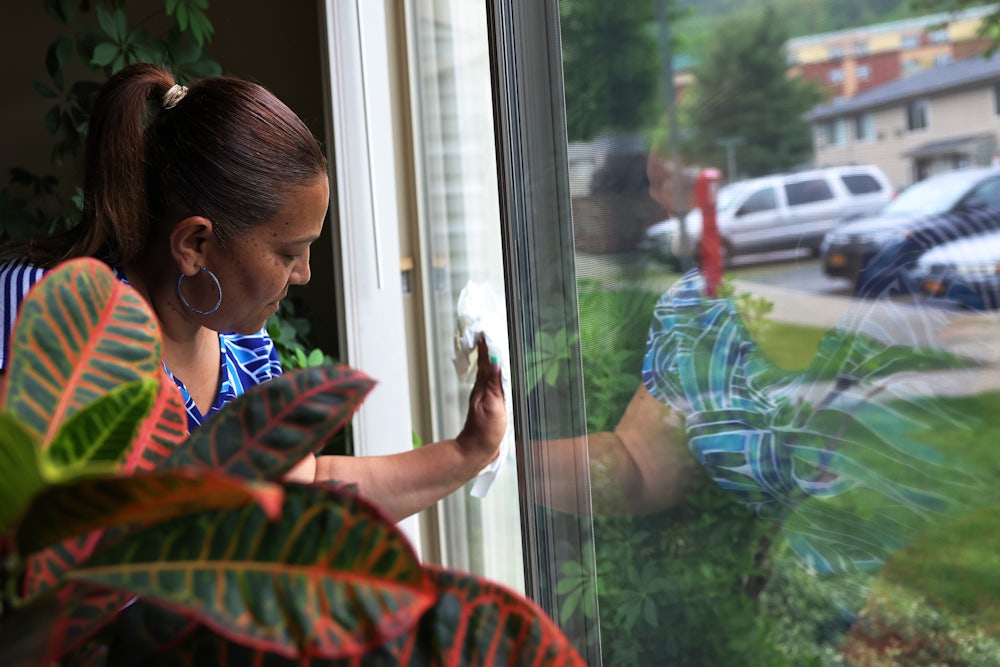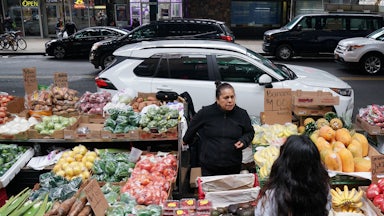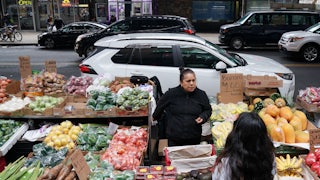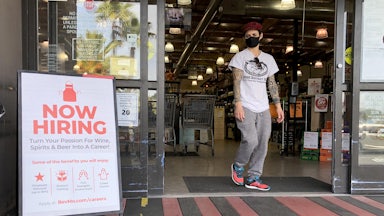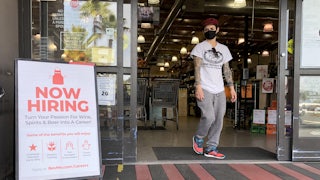At the start of the pandemic, as households locked down from fear of infection, Berta, a house cleaner from Mexico, lost most of her clients in Greensboro, North Carolina. Then schools closed, and Berta, a single mother, had to bring her 10-year-old daughter with her to the few houses that still employed her. “She was there studying while I cleaned,” Berta said.
In November 2020, Berta contracted Covid-19 and was sick for a month. (Like the other workers interviewed for this story, Berta asked to be identified by just her first name because of her legal status.) She spent three days at the hospital. She was behind on her bills—rent, water, power. She didn’t receive any unemployment benefits or emergency support. And then a hospital bill of almost $2,000 arrived. “I still don’t know how I’m going to pay. I still haven’t recovered,” Berta said in a recent interview.
Every month, the Bureau of Labor Statistics issues unemployment data, and over the last year and a half its figures have reflected the millions who lost their jobs due to shutdowns, infections, and social distancing measures. But Berta wasn’t captured in the data, not when she was working nor when she lost her multiple jobs.
There are an estimated 2.2 million domestic workers in the United States—house cleaners, nannies, and home care workers, among others. According to 2019 data, they are 91 percent women, often immigrants, and three times more likely to be living in poverty than all other workers. Yet policymakers, analysts, and researchers worry that they are being left out of official spreadsheets, even as they are some of those most affected by the pandemic. That means their needs may be ignored or underrepresented when officials design emergency plans and long-term economic policies. Policymakers are trying to respond to an economic recession of unprecedented dimensions in real time, and they need to make informed decisions quickly. Should the government increase unemployment insurance? Should it establish stricter public health standards? “What’s at stake here is a lot,” said Julia Wolfe, an analyst at the Economic Policy Institute.
Now that optimistic talk about economic recovery is permeating official statistics and the public discourse, these precarious workers are still missing from the picture. Of course, domestic workers aren’t the only ones being left out. App giants like Uber and Instacart, which depend on similarly contractless, temporary workers, have shared little information about how the pandemic is affecting the people who drive cars or carry shopping bags, despite being able to constantly track users’ performance with the most advanced technology.
One advocacy group has stepped into the void. The National Domestic Workers Alliance turned a tech experiment with worker communication into an emergency survey tool that is providing real-time, quality data on how Covid-19 is affecting the house cleaners, nannies, and home care aides who are the focus of NDWA’s organizing. All the group used was Facebook, and the data they are getting tells a very different story about this significant slice of the U.S. economy.
Years before the pandemic, NDWA had made it a priority to locate “invisible workers” and learn about their needs and working conditions. Since domestic workers operate mostly behind closed, private doors, the alliance went to find them where they already were—on the most popular social media network. In 2018, they created a Facebook page aimed at Spanish-speaking workers. They called it La Alianza, and shared relevant news and information: changes in regulations or immigration policy, tips on how to use cleaning products safely, upcoming events and protests. The workers were already used to chatting privately on the platform with friends and family, who often live abroad, so NDWA decided to launch a Facebook chatbot to interact with them more directly.
“What we found was that, actually, workers are really interested in engaging about their working conditions and answering questions,” said Tracy Anderson, an expert in workforce organizing and economic development who leads the La Alianza project at NDWA Labs, the group’s technology and innovation arm.
The number of chatbot subscribers quickly grew to more than 200,000 across all 50 states, as well as Washington, D.C., and Puerto Rico. In early 2020, Anderson and her team had already been thinking of using the tool for a monthly survey. But the project took on more urgency with the threat of the pandemic, and they switched to weekly questionnaires.
The first one went out on March 13, 2020, with the opening question: “Are you worried about Covid-19?” After that, NDWA sent the surveys every Friday evening, reaching around 80,000 workers each time. After six months, NDWA issued its first comprehensive report. The results were appalling: By late March, more than 90 percent of the domestic workers surveyed reported having lost jobs. By late May, over 70 percent reported they had no jobs at all.
The impact “was much faster and more extreme than in other sectors,” Anderson said. The surveys also found that three out of four respondents were the primary breadwinners in their households, that fewer than a third received Cares Act stimulus checks, and that over 90 percent of respondents did not receive unemployment benefits (many of the workers didn’t qualify for unemployment because they are undocumented immigrants). More than half of the workers were unable to pay their rent or mortgage, six months in, and over 20 percent were unsure whether they’d be able to afford food in the following two weeks. After that report, “a congressional staffer told us, ‘There’s data on the recession here that we’re not seeing anywhere else,’” Anderson said.
Domestic workers are still far from recovery, according to the most recent NDWA data. By August 2021, almost a year and a half into the pandemic, its surveys find joblessness at 28 percent. Equally worrisome are the figures on housing and food insecurity: Almost half of respondents are still struggling to pay rent, and three out of four were not able or unsure they could afford food for the following two weeks.
Roxana, a 45-year-old domestic worker in the Bronx, is always ready to answer NDWA’s questions when they come in on Fridays. By late March 2020, the mother of three had lost all her cleaning jobs.
Roxana, who is undocumented, was desperate for news about Covid-19 and immigration issues. NDWA’s page and the chatbot, she told me, made her feel important. “They gave us life, you know?” Roxana said. “I felt that we do have a say in this place, that we were not as invisible.”
Despite being run by bots, the surveys were designed as “a form of care,” not just a polling device, said Paulina Lopez, the only economist at NDWA and the one who processes and analyzes the survey data each week. “We want to make sure that workers really experience this as someone checking in with them,” Lopez said. “And them knowing that there’s someone out there that cares about how they’re doing and that knows that things are hard right now.” At the end of each survey, the bot shares links to relevant resources, such as how to apply for food stamps, where to find food banks, or the latest information on eviction moratoriums.
Early survey results confirmed an urgent need for cash payments for domestic workers who were struggling to cover their most basic needs and mostly cut out of government relief programs. The NDWA ended up raising more than $30 million, which it distributed in payments to workers like Roxana, who got $400 in June 2020. She invested the money in making tamales and selling them on the street—an idea she’d gotten from the La Alianza Facebook page. A few weeks later, she got another $200. That cash—$600 in total—was the only help she got during the pandemic. She never dared to apply for government support because of her immigration status. “I was afraid that it might harm me later on,” she said.
Domestic workers aren’t always thought of as gig
workers, though in practice, that’s what many of them are, bouncing from house
to house over the week, or day, without fixed employers and increasingly dependent on apps and their mysterious algorithms for scheduling and getting
paid. Palak Shah, the founder of NDWA Labs and its current director of social innovations, believes that the pandemic has made the connection with
tech-mediated gig work more obvious for many people. “A lot of work is starting
to look like the way domestic work has always looked,” Shah said.
There is no clear definition of a “gig worker” universally used by economists and academics, and even as an increasing number of people resort to such nontraditional work arrangements, institutions researching the trend in the labor market still have trouble finding specific figures. Cornell University’s Gig Economy Data Hub, one of the field’s leading research institutions, estimates that a quarter of the workforce participates in the gig economy in some capacity, and one in 10 American workers rely on it for their primary income.
Tech giants like Amazon and Uber own vast swathes of worker data that would be extremely helpful to those who are trying to deepen and systematize our knowledge on the gig economy, but the companies limit their access to specific collaborations with academic institutions and often charge for their data sets. Researchers say that it’s necessary for a third party or the government to collect the data, so that there isn’t a conflict of interest and they can ensure transparency and free access. “If this is happening in the private sphere, then that means companies are going to be deciding what is the most useful thing to measure, which might not be the most useful thing for workers or for other constituencies,” Wolfe said.
Given that gig work is overwhelmingly performed by people of color and other marginalized groups, gathering detailed demographic information is “hugely important, ” she added. “When you’re addressing, in particular, racial justice issues and issues affecting a smaller group of people, then the sample size is going to be smaller, even though the issue is, in fact, incredibly important. And so there just needs to be a more intentional effort to reach and include those communities in statistics in a representative way so that we’re able to ask more detailed questions.”
NDWA now releases a monthly economic indicators report for the domestic work sector, which goes out on the same day that BLS publishes its jobs report. The official data, Lopez says, sometimes shows a rosier portrait of economic recovery than their surveys reflect.
“We need to take a look at racial disparities and who is included when we talk about recovery,” Lopez said. “We can’t talk about economic recovery when the essential workers that run the economy are struggling to make ends meet. So we’re hoping that this is sort of a ‘side-by-side indicator’ of how, truly, the economy is doing.”
Berta and Maria, a 45-year-old house cleaner in Denver, also received small emergency payments from NDWA during the pandemic—about $500 each. “The first thing I did was fill up my refrigerator,” Berta said. The cash kept them going for another month.
Berta, Maria, and Roxana are all still struggling to stay afloat with the few clients who have kept them on, and still far from the number of jobs they had before the pandemic. Neither of them see domestic work picking up anytime soon. Many of their clients are still scared to let people into their homes. Others have had to cut costs themselves. Some were old and passed away due to Covid-19. “People don’t trust anymore,” Maria said.
This reporting was supported by National Geographic Society’s Emergency Fund for Journalists.
